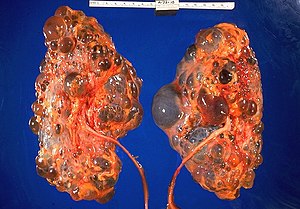Polycystic kidneys
| Polycystic kidney disease | |
|---|---|
 |
|
| Severely affected polycystic kidneys removed at time of transplantation | |
| Classification and external resources | |
| Specialty | Nephrology |
| ICD-10 | Q61 |
| ICD-9-CM | 753.1 |
| OMIM | 173900 |
| DiseasesDB | 10262 10280 |
| MedlinePlus | 000502 |
| eMedicine | med/1862 ped/1846 radio/68 radio/69 |
| Patient UK | Polycystic kidney disease |
| MeSH | D007690 |
Polycystic kidney disease (PKD or PCKD, also known as polycystic kidney syndrome) is a genetic disorder in which the renal tubules become structurally abnormal, resulting in the development and growth of multiple cysts within the kidney. These cysts may begin to develop before birth or in infancy, in childhood, or in adulthood. Cysts are non-functioning tubules filled with fluid pumped into them, which range in size from microscopic to enormous, crushing adjacent normal tubules and eventually rendering them non-functional also.
PKD is caused by abnormal genes which produce a specific abnormal protein which has an adverse affect on tubule development. PKD is a general term for two types, each having their own pathology and genetic cause: autosomal dominant polycystic kidney disease (ADPKD) and autosomal recessive polycystic kidney disease (ARPKD). The abnormal gene exists in all cells in the body: as a result, cysts may occur in the liver, seminal vesicles, and pancreas. This genetic defect can also cause aortic root aneurysms, and aneurysms in the circle of Willis cerebral arteries, which if they rupture, can cause a subarachnoid hemorrhage.
Diagnosis may be suspected from one, some, or all of the following: new onset flank pain or red urine; a positive family history; palpation of enlarged kidneys on physical exam; an incidental finding on abdominal sonogram; or an incidental finding of abnormal kidney function on routine lab work (BUN, serum creatinine, or eGFR). Definitive diagnosis is made by abdominal CT exam.
...
Wikipedia
